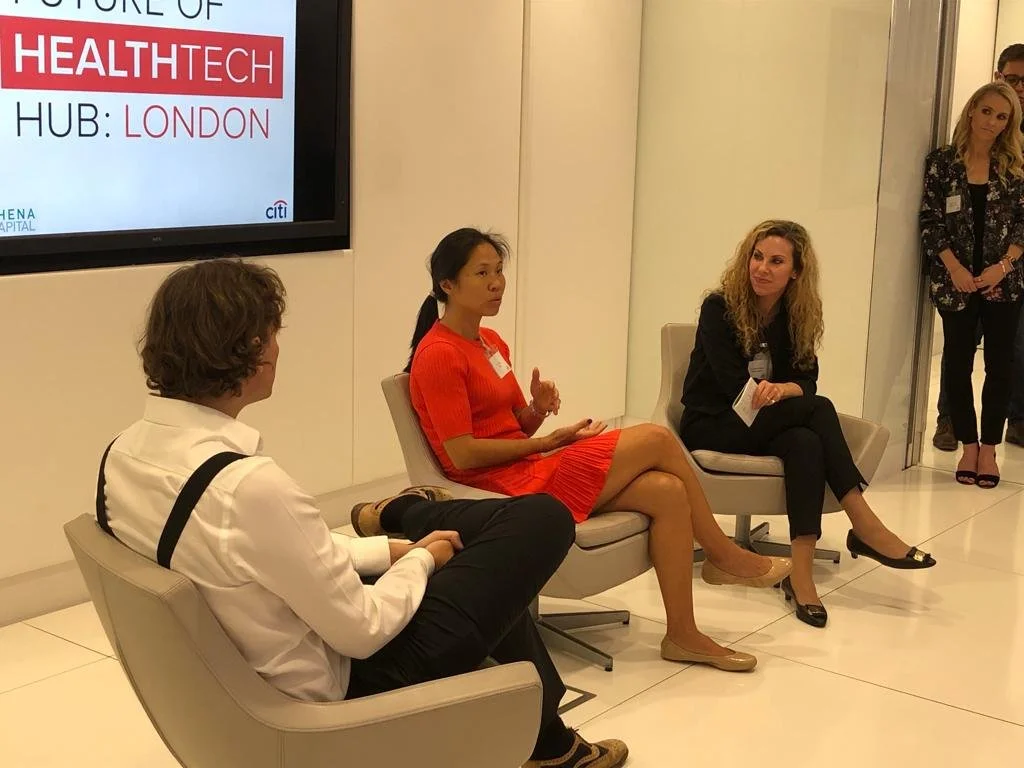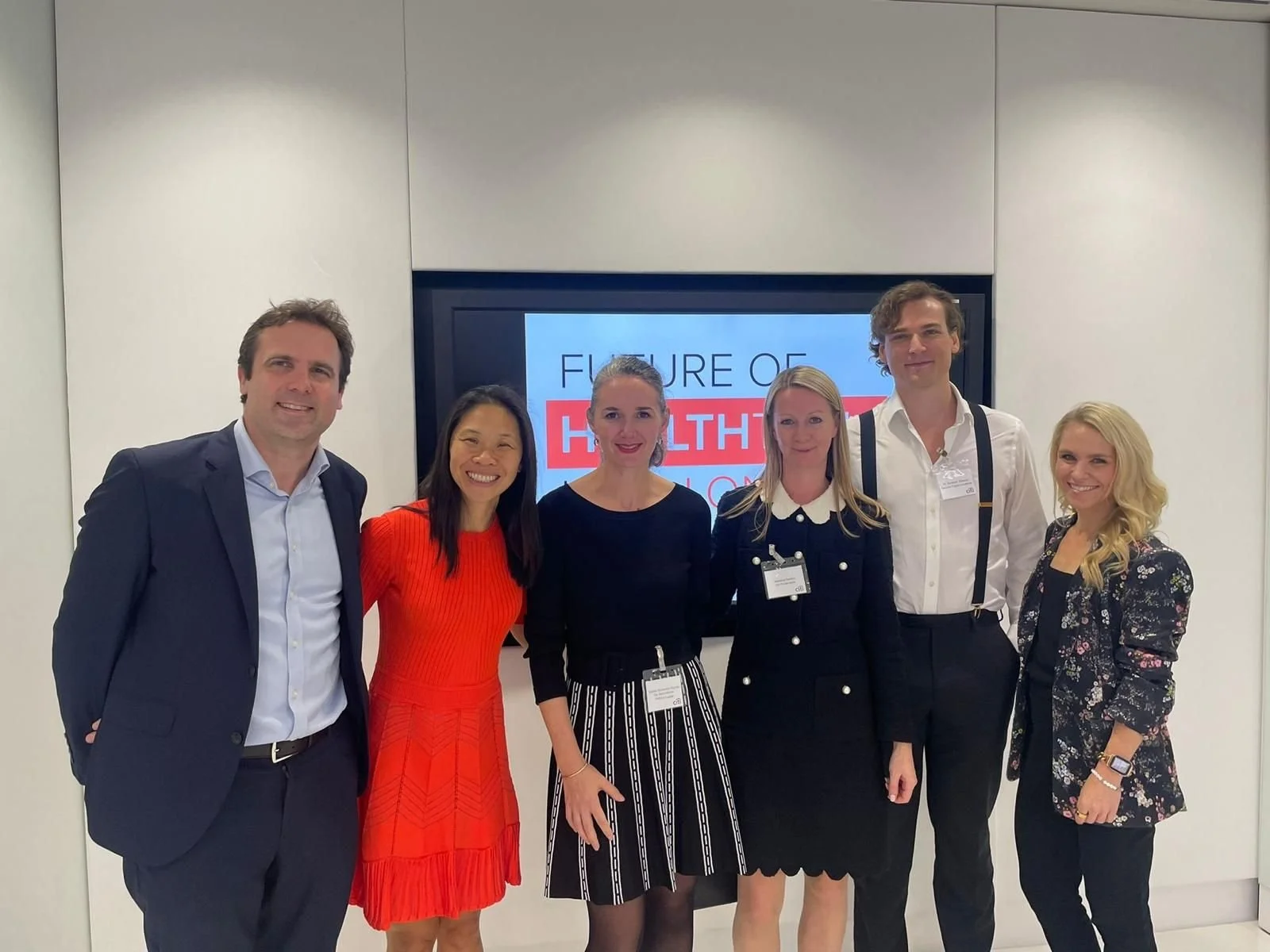Decorte <> Citi Bank / Thena Capital, panel and CEO interview on “pivoting”
On Thursday 13th of October, our CEO Dr Roeland Decorte was invited by Citi Bank and THENA Capital to speak at Citi’s HQ for the Future of HealthTech Hub event, alongside fellow entrepreneurial Founder and CEO Lina Chan.
The night's two panellists were asked by THENA Capital’s Dr Pamela Walker to talk about data-driven discovery and pivots.
Before the panel, Adam Spielman, Head of Health and Consumer @ Citi Global Insights, presented the new report on HealthTech. Consensus among researchers from Citi, the event organisers, panellists, and the audience, seemed to be that the next boom in healthtech will be led by services providing pre-diagnostic and preventative intervention and monitoring (often using AI). The key being to keep the process as frictionless as possible.
After the event, THENA Capital sought to capture some of the insights by sitting down with Roeland for a short interview (below).
Left to right: Joe Turpin (Citi Bank Commercial Banking), Lina Chan (CEO and Founder, Parla), Esther Reynal de st Michel Richardot (THENA Capital), Madeline Seddon (Citi Bank Private Banking), Roeland Decorte (CEO and Founder, Decorte Future Industries), Tatum Getty (THENA Capital).
1/ Roeland, what are the data points and inputs that most influenced your pivots?
In my view there are two main types of pivot: pivots of mission and pivots of approach. The former is a bit more dramatic and externally very visible: you literally change the reason why your company exists. The latter is more internal and less visible, often more nuanced. Most pivots are of approach - though I have seen pivots of mission completed successfully as well.
All pivots, I would argue, should be the result of discovery. When distinguishing between a good or a bad pivot, the question should always be: is it data-driven, is this the result of discoveries in the market and/or the Research and Development process?
The two main pivots we underwent at Decorte Future Industries, moving from exoskeleton-based to primarily audio-based technologies, and then from an end-to-end “ready-made service” to a device-agnostic “engine”, were both pivots of approach. The underlying mission remained the same: we wanted to livestream health data directly from the body into the cloud, in as unobtrusive a way as possible. So what was the data underlying the pivots?
The first was the result of discovery over the course of a long Research and Development process. Our exoskeleton tech was built to overcome the fact that health data is currently gathered only at specific points in time, when a sensor touches the human body. Our tech allowed a continuous link between the human body and the cloud, with embedded sensors continuously uploading data without the gel or expensive methods existing technologies used. We undertook significant bench and field testing, seeking to make the tech increasingly unobtrusive. The main limitation, it became increasingly clear, was the core need for skin contact, which in turn restricted our tech to custom garments (limiting it to sectors traditionally open to those, such as the UK MoD, which endorsed this path of our R&D, or the care sector).
As our mission had always been to enable health data gathering for the masses, we were continuously seeking further solutions and improvements. Early on, I became aware of research being undertaken at the University of Cambridge that explored new Machine Learning methods to extract accurate and wide-ranging health data simply from sound. This sound-based collection, if indeed possible, could in theory completely bypass our issue of skin contact. So, even as we were testing and building our exoskeletons, we began testing this sound-based technology, led by one of the leading researchers in that field, Decorte’s current Head of Machine Learning. One by one we were able to eliminate our sensors using just sound, and ultimately we eliminated even the exoskeleton and need for any body-covering at all. The rest is company history.
Contrary to what people might think, eliminating the exoskeletons I spent two years building myself before even starting the company was one of the easiest decisions I ever made (even if, of course, there were emotional attachments).
The second pivot, towards an engine-based approach for our sound-based AI, happened as a result of engagement with clients and the market. The decision slowly formed over the course of over a hundred customer and partner calls, when it became clear that lots of different clients had lots of different uses for our tech. The level of interest from big tech also very quickly became clear (Google, Microsoft, both of whom we are now working with), and we realised that either we could choose to become a specific application in an emerging field (a custom end-to-end solution solving a specific problem in a specific setting), or we could make a play to dominate that emerging field - creating the foundation everyone else would build on.
2/ Have you put in place any future touchpoints to assess the need for pivoting/ has it changed the way you manage/ track the opportunities in your space? How are you building Decorte Future Industries to be agile?
The main thing is to occasionally stop hurtling towards your goal and to question everything. It can be an exhausting process, but it tends to leave you and your team much more aligned and motivated in the end once you get through it. There has yet to be such a "review" meeting at the company that hasn’t been deeply impactful.
As the rather long answer above indicates, there are usually no shortcuts or single data points that immediately cause (good) pivots of approach: they are generally the result of thorough processes of discovery through R&D, testing, deployment, and interactions with the market. The ability to then respond to data rapidly and comprehensively is what gives startups their superpower.
If you haven’t pivoted in approach at all since you started the company, there's usually one of two reasons: either you got product-market fit exactly right at the beginning, in a near-prophetic way, or you are dogmatically sticking with your original approach despite the data. We all know which is the most likely.
Just like with sustainable growth vs growth at all costs, “speed” as a buzzword can, however, be dangerous. Speed is key for responding to, but not in all cases for gathering, data: there are definitely those who pivot too often and too early. Develop, deploy and test in rapid time, but don’t try to rush or cut corners during testing of technologies: you need systematic gathering of data across the board. If you do not go through the process of discovery completely, you will find yourself responding based on your initial reactions to data, jumping away as soon as things get challenging, rather than the data itself – missing the complete picture, and therefore also the way to hack it.
3/ How has this impacted how you lead your team?
Keeping the entirety of the team looped in as you gather that data is paramount.
Generally, if you employ the process above that we deploy at Decorte, the need for pivots (to respond to the data gathered) will eventually become self-evident to those that have done the gathering.
But there can be significant challenges to mitigate. If there is a market-driven pivot coming up, tech team members will not have experienced the build-up of data in the same way that commercial-focused members have, if at all, even though the decision will impact them equally. Similarly, the need to pivot because of an increasingly clear problem or opportunity on the tech side may seem bizarre to those outside of tech. It is surprising how hard it is to communicate in retrospect the totality of data that leads you to a pivot. If team members communicate consciously throughout, however, then the journey is shared, and so will likely be the point or opinion at which most arrive.
We make sure all teams sit together at least once a week and communicate the rough shape of the data they’re seeing, communicate their progress, and identify any blockages and dependencies.



